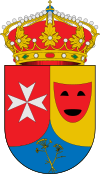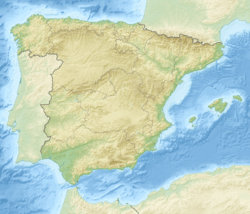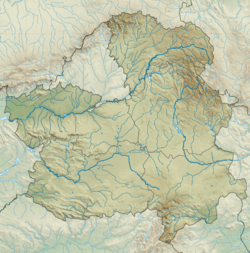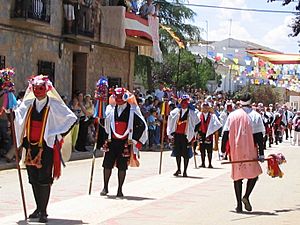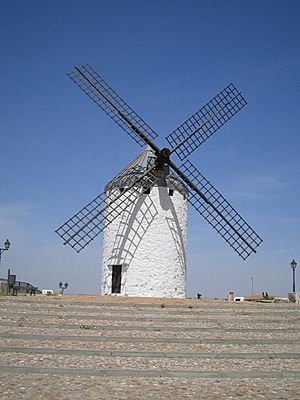Camuñas facts for kids
Quick facts for kids
Camuñas
|
||
|---|---|---|
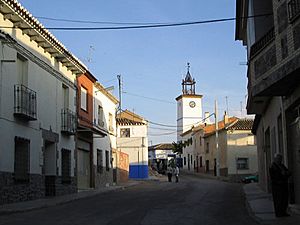
Calle Imperial and the Clock Tower
|
||
|
||
| Country | Spain | |
| Autonomous Community | Castile–La Mancha | |
| Province | Toledo | |
| Area | ||
| • Land | 102.03 km2 (39.39 sq mi) | |
| Elevation | 674 m (2,211 ft) | |
| Population
(2018)
|
||
| • Total | 1,740 | |
| Postcodes |
45720
|
|
Camuñas is a small town, also called a municipality, located in the province of Toledo, in the region of Castile-La Mancha, Spain. In 2018, about 1,740 people lived there.
Contents
What's in a Name?
The name "Camuñas" likely comes from an old Arabic word, kammuniya. This word can mean "like cumin," which is a spice. It can also mean "any seed that isn't a cereal or a bean." People think the name might have been a nickname for someone who helped resettle the area long ago during the Reconquista.
Camuñas's Special Shield
Understanding the Coat of Arms
A coat of arms is like a special symbol or emblem for a town or family. Camuñas has its own unique design. It features a red background with a silver, eight-pointed cross, which is a symbol of Saint John. There's also a gold mask with red eyes and black lips. At the bottom, on a blue background, you can see a golden cumin plant. A royal crown sits at the top of the shield.
The Meaning Behind the Symbols
Each part of the coat of arms tells a story about Camuñas. The cross shows that Camuñas was once connected to the Order of Saint John. The mask represents the town's special Corpus Christi celebration. The cumin plant reminds us of the crops grown in the area. This coat of arms was officially approved in 1986.
Where is Camuñas?
Location and Surroundings
Camuñas is nestled on the side of a mountain called Cabeza-gorda, which means "fat head." It sits on the left bank of the Amarguillo River, in the La Mancha region of Spain. The town shares its borders with other villages like Puerto Lápice and Herencia in Ciudad Real province. It also borders Madridejos and Villafranca de los Caballeros in Toledo province.
Exploring the Landscape
The area around Camuñas is mostly a wide, flat plain called a meseta. However, the southern part is hillier, with cliffs, deep valleys, and mountains that can reach up to 1,000 meters (about 3,280 feet) high. To the west, there's a grassy area that stretches to the Amarguillo River. You can also find a hill called Cañada de las Vacas near the main highway, the autovía del Sur. On one side of the road, there's a hill with old mine entrances, some of which are very deep.
A Glimpse into History
Early Settlements and New Beginnings
People have lived in the Camuñas area for a very long time. We know this because archaeologists have found old Roman and Arab items like lamps, pottery, and grave markers. There's also evidence of ancient settlements in places like Las Varas, Palio, Lerma, and Los Villares de Almaén.
After the Reconquista, around 1276, the Order of San Juan helped new people settle here. Camuñas started as a small village that was part of a larger town called Consuegra.
Becoming a Town
In 1557, Camuñas gained the special right to be called a villazgo, which means it became its own town. Princess Joanna of Austria granted this right. At that time, Camuñas had about 160 families, which was around 800 people. Since the 18th century, San Nicasio has been the town's patron saint.
The French Invasion and Local Heroes
In the early 1800s, France invaded Spain. This led to a resistance movement where small groups of fighters, called guerrillas, fought against the invaders. Camuñas was home to one of the most important guerrilla leaders in the region during the Peninsular War, known as Tío Camuñas.
A Brief Rebellion
Years later, a nobleman named Luis Villaseñor y López de la Oliva became mayor. He had some disagreements with local authorities. During the First Spanish Republic, some towns tried to form their own independent areas called cantons. Camuñas also formed its own canton, the Canton of Camuñas, but it only lasted a few days. It was a small, interesting event in the town's history.
What Camuñas Makes
The main way people in Camuñas make a living is through farming. They are especially known for producing:
- Wine: With a special quality label called "La Mancha."
- Olive Oil: Known as "Montes de Toledo."
- Saffron: A valuable spice, with the label "Saffron of La Mancha."
Fun and Festivities
Camuñas has some unique traditions and celebrations.
Special Holidays
- Pecados y Danzantes de Camuñas: This festival happens on the same day as Corpus Christi. It's a very old tradition, possibly from the 1500s or 1600s. During the festival, people act out and dance, showing a fight between "the bad" (pecados) and "the good" (danzantes). It's a very important event and is recognized as a Regional Tourist Interest.
- San Nicasio: This is the patron saint of Camuñas. The town chose him as their patron in the 17th century after a serious sickness spread through the area, and they prayed for his help.
- Francisquete (Tío Camuñas) Festival: Held on the first weekend of August, this festival recreates how Francisquete, the local guerrilla leader, fought against the French.
Places to See
- Iglesia parroquial de Nuestra Señora de la Asunción: This is the main church in the town's historic center. It was built on the remains of an older building and has a beautiful tower in the Mudejar style. It was restored in the 18th century.
- Clock Tower: This tower has a clock that was bought in 1910. It stands in Plaza de Ramón y Cajal, right next to the parish church.
- Molino de la Unión: This is a traditional windmill located near the top of Camuñas's tallest hill. Its name, "Union Mill," comes from the fact that the whole town worked together to rebuild it after a big fire. It's considered an important cultural site.
- Camuñas Ethnological Museum: This museum focuses on the town's most famous festival, Pecados y Danzantes de Camuñas. You can find it to the west of the town, close to the Amarguillo River.
- Ermita de la Veracruz: A small chapel.
See also
 In Spanish: Camuñas para niños
In Spanish: Camuñas para niños


